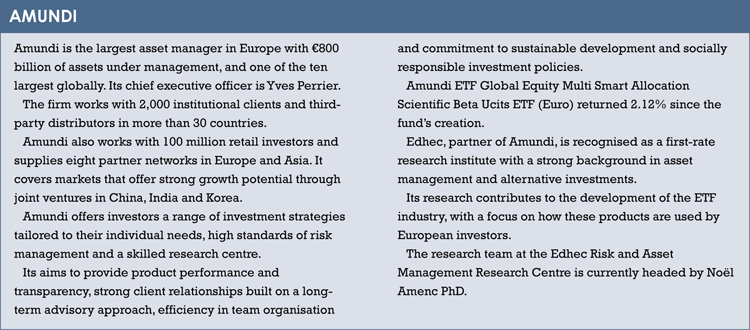For Amundi, there is no single solution to smart beta, and appreciating the diverse range of approaches is vital. This is what Amundi’s clients are doing, or planning to do.
Laurent Trottier, GlobaL head of index and smart beta management for Amundi, has claimed that as clients move away from the single minimum volatility approach to a wider smart beta range, they are now diversifying investments to incorporate new approaches.
“This market is fast growing and we think that it will continue to expand for the next few years, but there are a lot of specificities and parameters to be taken into consideration,” Trottier says.
“At Amundi we take an agnostic approach. We are already managing around €8 billion of smart beta assets, and we are proposing both active and passive solutions.
“We can offer single strategies, such as minimum volatility or risk parity, but also new key strategies where we aggregate different approaches.”
Frédéric Samama, deputy global head of institutional and sovereign clients at Amundi, says there is no ‘magic bullet’ when it comes to making smart beta work.
“Every strategy has its pros and cons and some specific risks. By having all the strategies in house we can deliver a more tailor-made solution. Active, passive, mono or a specific combination of strategies,” he says.
Samama adds: “At Amundi we feel it is important to combine this tailored approach with transparency and the desire to work alongside our clients with a long-term perspective.”
Amundi, which has more than €800 billion assets under management, recently formed a partnership with Edhec Risk Scientific Beta, creating a further addition to what is already a strong research department. This has been essential in educating clients on the subtleties found in smart beta.
BEYOND MARKETING
Samama says: “About one third of our institutional clients are already using smart beta, and roughly another third is considering it in the near future.
“Our clients are now trying to understand and analyse the pros and cons of each strategy.”
Trottier says that generally, investors have either used smart beta already, and are looking for new options to complement their existing positions, or are just beginning to discover how smart beta could work for them.
“It is important that they know that smart beta products will perform differently in varying market regimes. We try to make sure they clearly understand what is behind smart beta, and how they can make best use of it.” In June, Amundi launched the Global Equity Multi Smart Allocation Scientific Beta Ucits ETF, which is linked to the Edhec-Risk Institute’s Scientific Beta Developed Multi-Beta Multi-Strategy Index.
Trottier says: “We have decided to play a lot on the diversification aspect by mixing four main risk factors with five popular diversification strategies. The solution works for agnostic clients, who do not have a preference between minimum volatility or maximum deconcentration or equal weightings, and that’s also a way of being quite resistant – it’s a kind of all-weather behaviour.”
LONG OUTPERFORMANCE
Samama believes that for clients to benefit from smart beta specificities they must have a long-term investment horizon and the internal capabilities to assess risks and to potentially adapt benchmarks accordingly.
“It’s absolutely key because these strategies will outperform, but over the long run. A long-term investment horizon, gives a competitive advantage and smart beta strategies are the way to monetise that advantage. You need to have a risk budget. You need to be comfortable with the rationale behind the strategy, and maybe moving away from the market-cap weighted index as the benchmark if you allocate a significant part of your portfolio.”
Another focus for Amundi is taking care to minimise cost and turnover, one of the main drawbacks of smart beta. Various teams at the firm are working on smart beta, and it continues to develop its research into different ways to combine smart beta and adapt the mix based on market anticipations.
“I’m sure that in the next five years there will be more investment in smart beta and more assets managed in this way.
“Customisation will be key in order to ensure all investment solutions meet the needs of each new investor,” Trottier concludes.

©2014 funds europe





